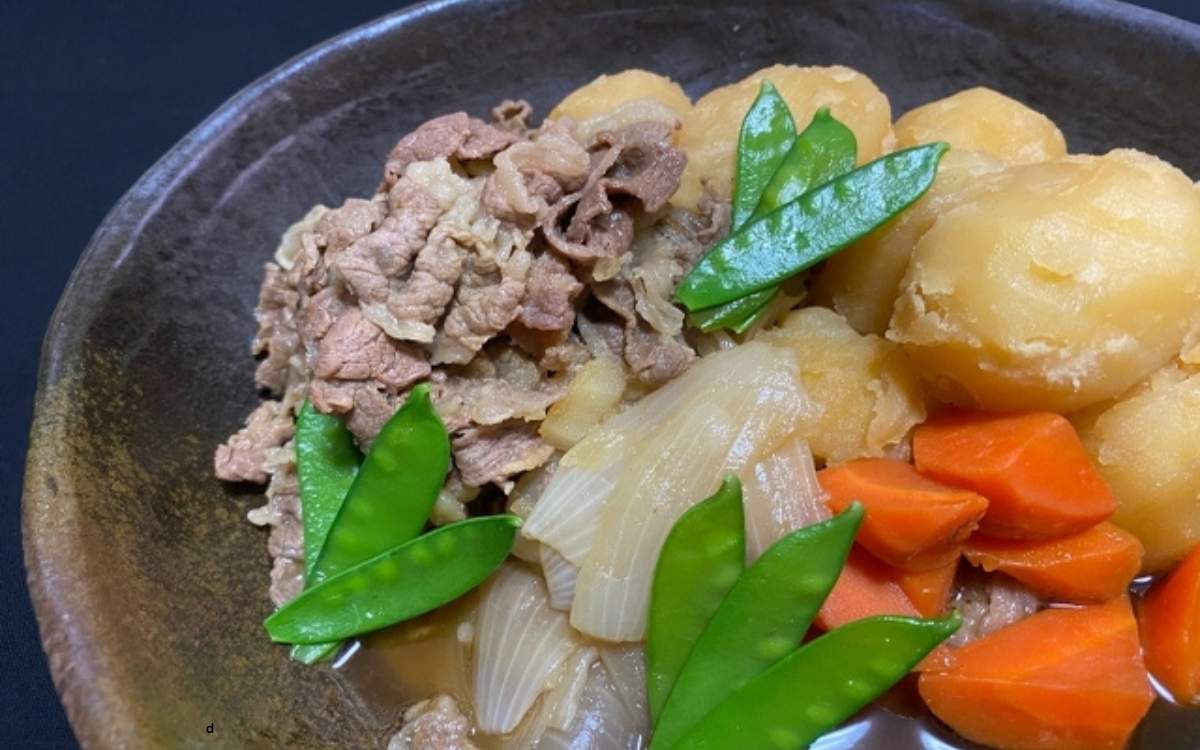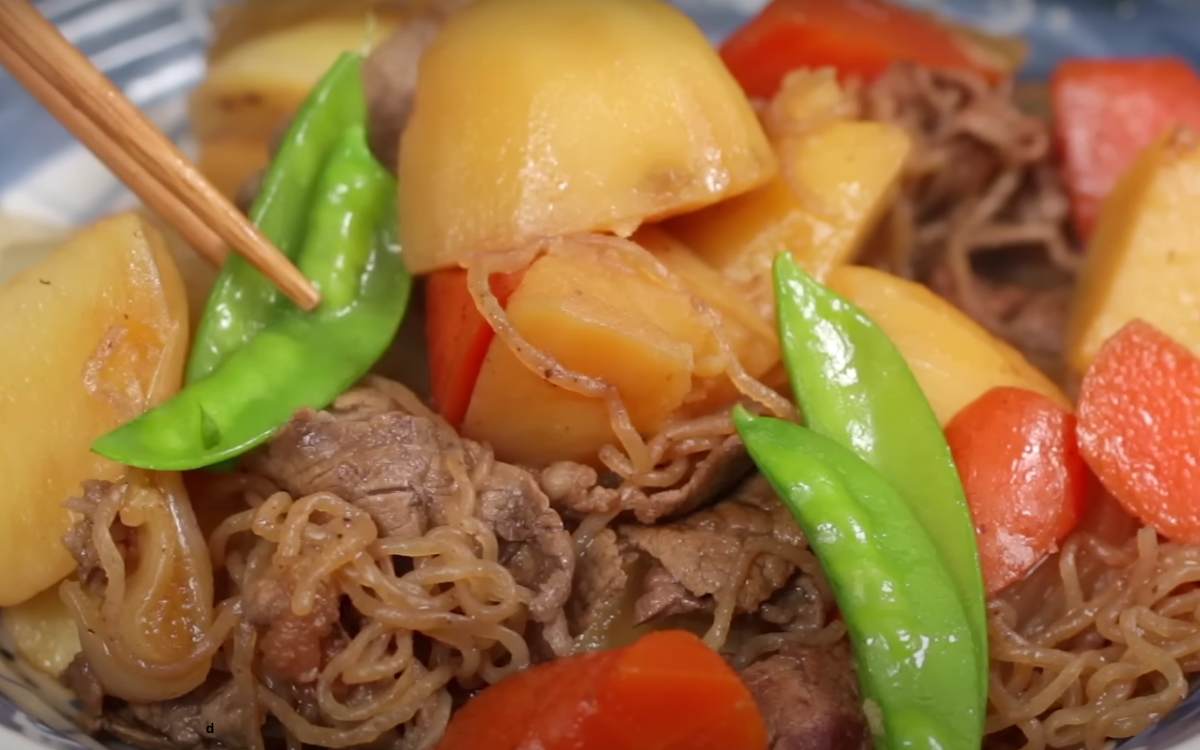When I think about comfort food, my mind instantly drifts to Nikujaga (肉じゃが)—a dish that feels like a warm hug in a bowl. Nikujaga, which translates to “meat and potatoes,” is a classic Japanese homemade meal that has been loved for generations. It’s not fancy or complicated, but that’s the beauty of it.
Growing up, I remember my first taste of Nikujaga at a friend’s house during a cozy dinner. The rich aroma of soy sauce, the sweetness of the broth, and the soft, tender potatoes left a lasting impression. It felt like something you’d want to eat after a long day, sitting around the table with family.
Made with simple ingredients like pork, potatoes, carrots, onions, and konyaku noodles, everything is simmered together in a sweetened soy-based sauce. The result? A dish that’s bursting with flavor and filled with contrasting textures—from the soft potatoes to the slightly chewy konyaku noodles. It’s hearty, filling, and perfect for scarfing down on a chilly evening.
Whether you’re new to Japanese cuisine or just looking for an easy, soulful dish to add to your repertoire, Nikujaga is a must-try. Let’s dive into what makes this humble yet flavorful meal so special!
To make a delicious pot of Nikujaga, you don’t need a long list of fancy ingredients—just a handful of simple, wholesome items that you can easily find at your local grocery store or Asian market.
Equipment
-
1 Cutting board and knife
-
1 Large pot or deep skillet:
-
1 Wooden spoon or spatula
-
1 Measuring spoons
-
1 Bowl and chopsticks (optional)
Ingredients
- 200 grams Sliced beef Thinly sliced; substitute pork if preferred
- 3 medium Potatoes Peeled and cut into bite-sized chunks.
- 1 large Onion Thinly sliced for a sweeter flavor.
- 100 grams Konyaku noodles Optional; rinse well before adding.
- 3 tablespoons Soy sauce Adds savory umami flavor.
- 2 tablespoons Sake For depth and mild sweetness.
- 2 tablespoons Mirin Sweet cooking rice wine.
- 1 tablespoon Sugar Adjust based on desired sweetness.
- 2 cups of water—just enough to cover the ingredients.
- 1 tablespoon Cooking oil For sautéing beef and onions.
- 2 medium Carrots Sliced into rounds or half-moons.
- 4-9 green vegetable most commonly snow peas, green beans, or green peas

Here’s How I Use
Ingredients:
- Potatoes: I like to use starchy varieties like russets because they break down slightly while cooking, making the dish extra creamy.
- Carrots: Just a couple of medium-sized ones for a hint of sweetness and color.
- Onions: Yellow onions work best; they add a natural sweetness as they stew.
- Sliced beef: – Thinly sliced beef is ideal for this dish. I often find pre-sliced beef at the Asian market, but if you can’t find it, you can freeze a steak for about 20 minutes and then slice it thin yourself.
- Soy sauce, sake, mirin, and sugar – These are the backbone of the dish’s sweet and savory flavor. I always keep these staples in my pantry for Japanese cooking.
- Dashi: This Japanese soup stock gives Nikujaga its depth of flavor. If you don’t have dashi on hand, you can substitute it with chicken or vegetable broth, but I highly recommend trying dashi if you can.
- Water—just enough to bring everything together.
I usually grab my vegetables from the farmer’s market for the freshest produce, and I restock my Japanese pantry items at a local Asian market or order them online if I’m in a pinch. Trust me, once you have these ingredients at home, you’ll want to whip up Nikujaga (and other Japanese dishes) all the time!
Now that we have everything ready, let’s get cooking!
Estimated Cost
- Total Cost: $10–$15 (depending on where you buy the ingredients)
- Potatoes: $2–$3
- Carrots: $1–$2
- Onion: $0.50–$1
- Sliced beef: $6–$8
- Soy sauce, sake, mirin, sugar: $2–$3 (if you already have these, the cost is much lower!)
Tip: Buying in bulk at an Asian market can help reduce costs if you plan to cook more Japanese dishes.
How to Prepare Nikujaga: A Step-by-Step Guide
Cooking Nikujaga is like crafting a warm, flavorful memory—each step fills your kitchen with the aroma of comfort and tradition. The best part? It’s super simple and doesn’t require advanced cooking skills.
Just follow these steps, and you’ll have a pot of hearty Nikujaga ready to serve!
Step 1: Prep Your Ingredients
Before you start cooking, take a moment to prep everything. Peel and dice the potatoes into bite-sized chunks—they should be big enough to hold their shape but small enough to cook evenly. Slice the carrots into rounds or half-moons for a nice visual appeal, and thinly slice the onions.
For the beef, if it’s not pre-sliced, pop it in the freezer for about 20-30 minutes. This makes it firm enough to slice thinly. Thin slices cook quickly and soak up all the flavor!
Tip: Don’t worry about perfectly shaped veggies—this is a homey dish, and the rustic cuts add to its charm.
Step 2: Sauté the Beef and Onions
Heat a tablespoon of oil in a large pot over medium heat. Once the oil is hot, toss in the sliced onions and beef. Sauté them together, stirring occasionally, until the onions become translucent and the beef is lightly browned.
I always love this step because the aroma of onions caramelizing and beef sizzling fills the kitchen, making it feel so inviting. It’s the kind of smell that makes everyone wander into the kitchen to ask, “What’s cooking?”
Step 3: Add the Vegetables
Once the beef and onions are cooked, add the diced potatoes, carrots and peas to the pot. Give everything a quick stir to coat the vegetables in the flavorful beef juices.
Personal Tip: I sometimes add a handful of konyaku noodles here for extra texture. They’re slightly chewy and soak up the broth beautifully!
Step 4: Create the Flavorful Broth
Now it’s time to add the magic. Pour in equal parts soy sauce, sake, mirin, and a spoonful of sugar. Adjust the ratio to suit your taste—I usually start with about 3 tablespoons of soy sauce, 2 tablespoons each of sake and mirin, and 1 tablespoon of sugar. Add just enough water to cover the ingredients, then bring everything to a boil.
This step is where the dish starts to come to life. The savory soy sauce mixed with the sweetness of sugar and mirin creates that signature Nikujaga flavor.
Step 5: Simmer Until Tender
Once the liquid comes to a boil, lower the heat to a gentle simmer. Cover the pot with a lid and let it cook for about 20-30 minutes, or until the potatoes and carrots are tender. Stir occasionally to make sure nothing sticks to the bottom.
As the dish simmers, you’ll notice the liquid reducing into a slightly thick, flavorful sauce that coats everything beautifully.
Tip: If you like your Nikujaga a little saucier, you can add a splash of water or dashi halfway through cooking.
Step 6: Serve and Enjoy
Once the vegetables are soft and the sauce has thickened, your Nikujaga is ready! Serve it hot, preferably over a bowl of steaming white rice, for the ultimate comfort meal.
I love garnishing it with a sprinkle of green onions or even a little freshly cracked black pepper for an extra touch of flavor. And don’t forget—this dish tastes even better the next day, as the flavors continue to meld together.
Nikujaga is more than just a meal; it’s a dish that brings people together. Whether you’re enjoying it with family or serving it at a cozy dinner with friends, it’s bound to leave everyone satisfied and smiling. So, roll up your sleeves, start cooking, and savor the joy of this timeless Japanese comfort food!
| Nutrient | Approximate Amount Per Serving |
|---|---|
| Calories | 300–350 kcal |
| Protein | 15–20 g |
| Fat | 8–12 g |
| Carbohydrates | 40–45 g |
| Dietary Fiber | 4–6 g |
| Sugar | 10–12 g |
| Sodium | 800–900 mg |
| Potassium | 600–700 mg |
| Vitamin A | 2000–2500 IU |
| Vitamin C | 15–20 mg |
| Iron | 1.5–2 mg |
Notes:
- The nutritional values may vary depending on portion sizes, ingredient brands, and specific ratios used.
- This estimate assumes one serving includes approximately 100 g of beef, 2 medium potatoes, 1/2 carrot, and 1/4 onion.
- For a lower-calorie version, you can reduce the sugar or substitute low-sodium soy sauce.

